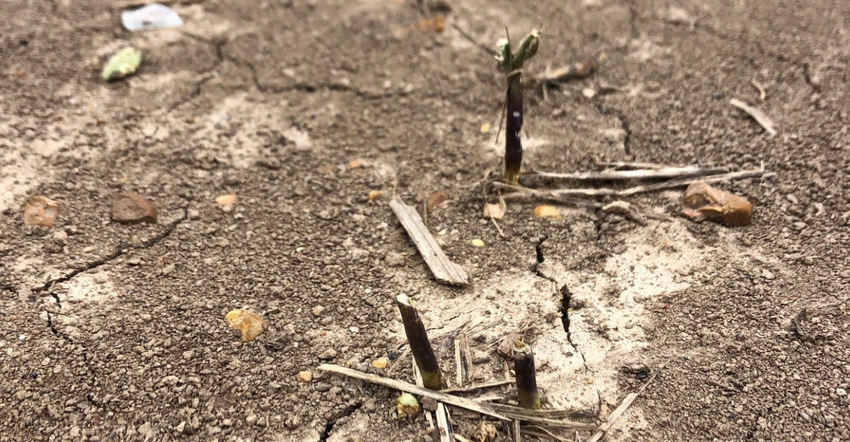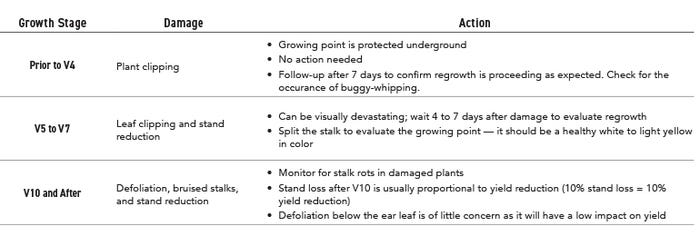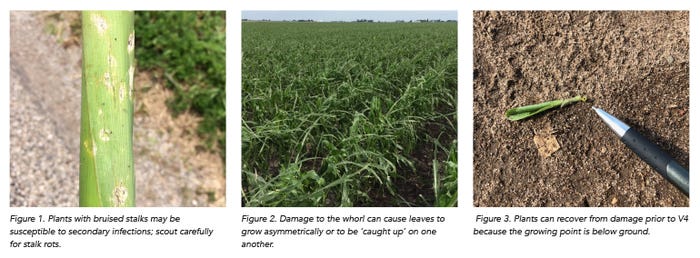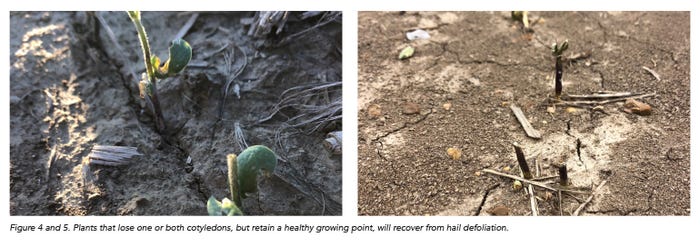July 1, 2020

With summer heat comes summer storms- and occasionally, hail damage. The impact (no pun intended) of hail on your crop depends on the severity of the initial damage, the growth stage of the crop, and weather conditions as the crop recovers.
CORN:
Hail is an abiotic stress on the plant that can cause yield reduction in three ways: population reduction, defoliation of leaf tissue, and physical injury to the ear, stalk bruising, etc.

Wherever defoliation occurs, look for exposure of the soil surface between rows. There may be a need for an additional herbicide pass to control weed competition, keeping in mind all herbicide labels for crop growth stage and height.
If you are making a pass across the field, consider including a fungicide as damaged leaf tissue is susceptible to infection. Fungal infections such as gray leaf spot, northern corn leaf blight, and rust typically do not enter the plant via an injury, but the damage may affect the plant’s ability to resist these diseases. Bacterial diseases such as Goss’s wilt will vector through an injury site but are unaffected by fungicides. The application of a strobilurin fungicide may help strengthen weakened stalks through increased lignin production and reduce stress during the plant’s recovery. Applying a fungicide is primarily for late-season plant health and standability, and not directly correlated to increased yield.
Hail damaged corn can also run the risk of increased nitrate levels when there are high soil nitrogen levels. Nitrate tests could help determine the appropriate management decision if the crop is intended as forage.
Continue to scout. Hail damaged crops can increase the risk of poor standability due to damage or infection of the stalk tissue. Having a plan to get the crop out efficiently can help save yields.
Crop insurance uses a standard yield loss chart based on the stage of corn. It is very important to know the date and time of the storm as well as the exact stage of corn to be as accurate as possible. Wait until the adjuster has established the level of injury to the field before making any decisions.


SOYBEANS:
Soybeans are resilient when it comes to hail damage, but they are still susceptible to significant yield loss in their early growth stages. Prior to VC (cotyledon stage), when the hypocotyl arch (shepherd’s hook) is exposed, is when soybeans are the most sensitive to a hail event. Once the cotyledons have formed, soybeans are likely to survive if one cotyledon or leaf tissue remains intact. The soybean plant initiates regrowth from the axillary buds located at the joint of the stem and leaves to compensate for earlier damage.
If stand reductions are severe enough to warrant replant, it is not advisable to terminate the remaining stand. Interplanting seed at an angle to the existing rows will limit damage to surviving plants.
A fungicide application may be beneficial if the hail event occurred in the reproductive stages (before R1). The ideal timing for this application would still be R3 to maximize the ROI of the application. The same rules for applying a fungicide to an injured corn crop, mentioned in the corn section, still apply to a soybean crop.

Any defoliation event is a bad day for a plant, but most hail damage is spaced across the field in a way that the surrounding plants can compensate to mitigate impact to yield. Consult your local Beck’s representative to learn more about how hail may impact your crops this year.
Beck’s is the largest family-owned retail seed company in the United States that serves farmers in Illinois, Indiana, Iowa, Kentucky, Michigan, Minnesota, Missouri, Ohio, South Dakota, Tennessee, and Wisconsin. According to a recent seed industry survey, Beck’s ranks as the fourth largest corn and soybean brand in the United States. At their core, all Beck’s employees are Farmers at Heart. It stands for something special. It has soul. It has truth. And it represents a community of farmers, employees, and dealers who strive each day to seek challenges, push boundaries and innovate. Beck’s has, and always will be, proud to serve a community of farmers who love what they do and who are proud to be… Farmers at Heart. For more agronomic new and information, visit Beck’s Agronomy Talk page or blog at BecksHybrids.com.
About the Author(s)
You May Also Like




